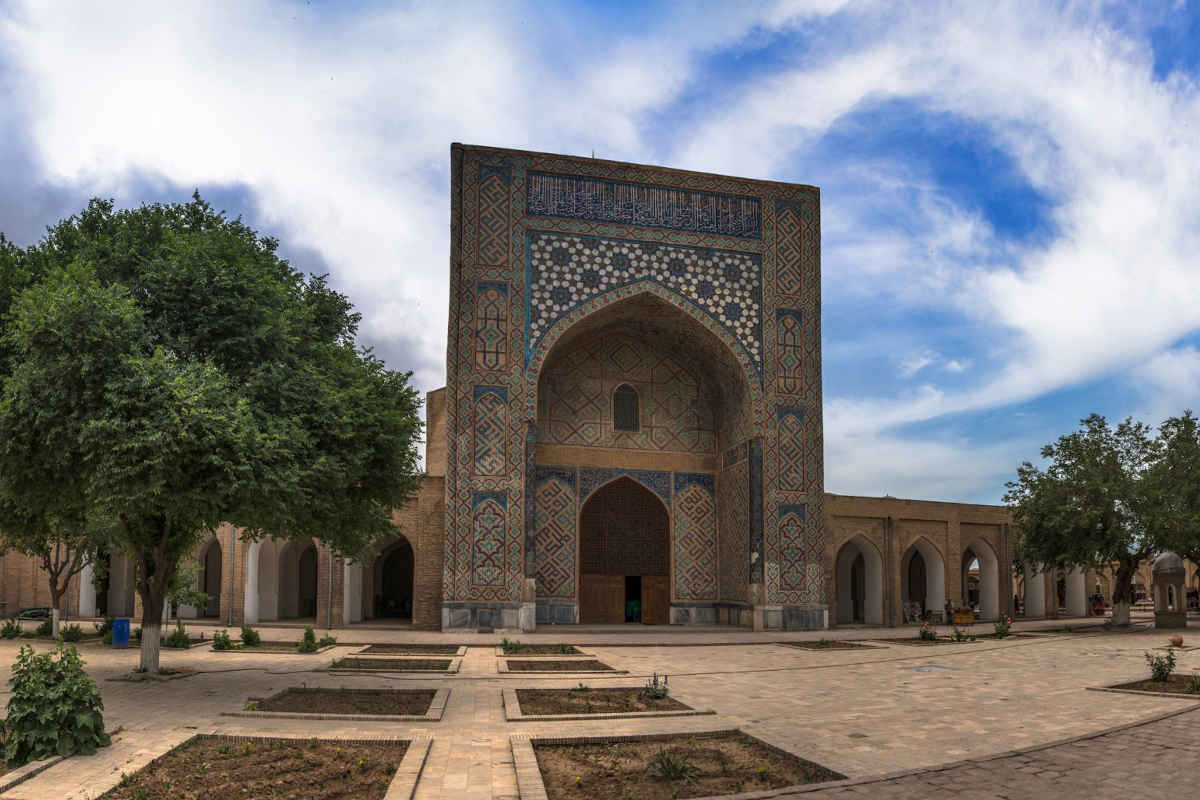Shakhrisabz - Kok Gumbaz Mosque
The Kok Gumbaz Mosque was built in 1435 at the behest of Ulugbek’s father Shahrukh in Shakhrisabz. This former Jome mosque was built on the foundations of a pre-Mongol mosque with a similar layout.
Summer galleries once adjoined the Kok-Gumbaz mosque, of which the bases of the square pylons supporting the arches remain, with numerous domes thrown between them.

Between the Dorus-Saodat and Dorut-Tilovat ensembles was another religious monument – a necropolis of the local nobility and clergy. Among the majestic palaces and memorial complexes of Shakhrisabz, the blue dome – Kok Gumbaz – rises directly from the green gardens.
Due to its location and size, it is visible from almost every part of the city. This makes Kok Gumbaz an irreplaceable element of the city panorama. Kok Gumbaz means “Blue Dome”.
The mosque was built in 1435 on the remains of an earlier building located in the Dorut-Tilovat architectural complex, with its front facing the mausoleum of Shamsiddin Kulol.
In fact, Kok Gumbaz Mosque is the largest Friday mosque in Shakhrisabz and all the important services were held here. The initiator of the construction of this mosque was Mirzo Ulugbek – world famous scientist-astronomer, public figure and grandson of the great Amir Temur.
On the portal of the main entrance of the mosque is an inscription stating that Ulugbek built Kok-Gumbaz on behalf of his father – Shakhrukh. The Kok-Gumbaz mosque was built on the foundations of the pre-Mongol building and the architects followed the layout of the old building during construction.
Summer galleries once adjoined the mosque, of which the bases of square pylons are preserved, supporting arches that were covered with numerous domes.
The mighty pylons of its eastern portal were decorated with ornaments and the tympanum had a mosaic star-girikh so typical of Ulugbek’s era. On the portal there is an inscription in Arabic: “This Jome Mosque is the most beautiful mosque in a high place; it has a large dome. This dome in Shakhrisabz looks like the blue sky above the green city”.
The pylons of the main portal have spiral staircases leading to the roof. The Guldasta tower, which resembles a small minaret, adjoins the pylons. The lower part is covered with marble, the upper part is crowned with the majolica capital.
On the north and south façades are the open corridors leading to the interior of the mosque.When planning the building, the architects tried to make its height as high as possible so that its axis was at the same level as the Kulol Mausoleum.
This made it possible to achieve perfect symmetry between the structures, giving the whole complex a very harmonious and studied style. To achieve this, the masters even had to violate Islamic law by changing the direction of the mosque towards the holy Mecca.
The spherical blue dome is covered with sky-blue ceramic tiles, symbolising the cloudless sky above the ruler’s vast domain.
From a distance, merging with the sky, it resembles a balloon, creating the illusion of lightness and flight. Below, around the base of the dome, is a light-coloured strip inscribed with extracts from various suras of the Qur’an.
The beautiful calligraphic script, so characteristic of the Timurid period, contains many wise and famous sayings. The most beautiful and important is this: “Power and wealth belong to Allah. Only Allah possesses dominion”.
Upon entering the building, we see that the interior is square. Immediately the scale and dimensions of the dome are felt differently. Loaded and majestic, it towers high above our heads.
The diameter of the dome is 46 metres. Here the sounds of voices and actions come alive and merge into a bizarre and at the same time threatening echo. At the corners of the massive walls are four spiral staircases that lead to the upper level, to the rooms and to the roof.
The surface of the walls inside the mosque is covered with white ganch (mixture of plaster and clay). In some places there are finely painted ornaments and patterns done in shades of blue and blues.
Near the walls are the niches that face the sides of the world. The interior of the Kok Gumbaz Mosque is almost square in plan and has four deep niches oriented on the sides of the world.
The mihrab is located in the western niche, which is filled with ganch stalactites. The entire surface of the walls of the mosque has been plastered with white ganch and painted with the finest blue-blue ornaments.
For several centuries Kok-Gumbaz Mosque was the main Jome Mosque of Shakhrisabz, and to the east of it was a mazar during the reign of Ulugbek, where the tombs of the nobility and clergy of the Barlas family, to which the Timurids belonged, are preserved.
The marble tombstones bear the names of commanders who took part in the campaigns of Shahrukh and Ulugbek.
